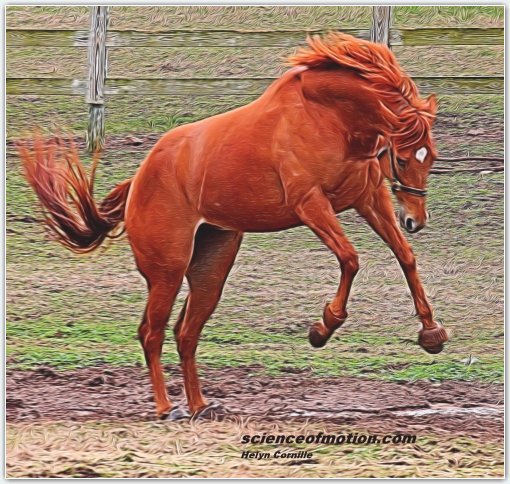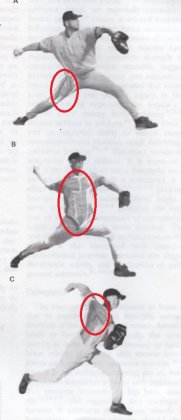Mechanoresponsiveness 22
Mechanoresponsiveness 22
Jean Luc Cornille

“Suspension and amplitude are not created by stretching and relaxation but instead by appropriated stiffening of elastic structures.” (Jean Luc Cornille)
Any movement, during gait and performances, is created through a series of eccentric contractions enhancing the power of the following concentric contraction. LaStayo and his colleagues, use the example  of a baseball pitch where a series of eccentric contractions followed by concentric contractions start with the propulsive leg all the way to the hand throwing the ball through the torso and shoulder. Hind legs, back, and forelegs of the horse use the apply the same muscular work. A series of eccentric contractions store elastic strain enhancing the power of the following concentric contraction.
of a baseball pitch where a series of eccentric contractions followed by concentric contractions start with the propulsive leg all the way to the hand throwing the ball through the torso and shoulder. Hind legs, back, and forelegs of the horse use the apply the same muscular work. A series of eccentric contractions store elastic strain enhancing the power of the following concentric contraction.
“For example, during a baseball pitch or a high jump, a series of eccentric contractions in both the lower and upper extremities precedes concentric contractions. During the windup, cocking, and late cocking phases of a throwing motion, the trunk and lower extremities, coupled with the internal rotators of the shoulders, store elastic strain energy via eccentric lengthening prior to transitioning to the accelerating concentric phase.”
In almost all sport activities, the benefits of the Stretch-Shorten Contraction phenomenon are the energy behind greater and sounder performances. In previous discussions, it was pointed out that horses, like all living creatures are constructed of tiers of systems within a system within a system. Our direct influence as a rider is limited to the superficial systems, However, efficiency in gaits and performances as well as soundness, relies on proper orchestration of the deeper systems. We can, as a rider, guide the horse’s brain toward subtle orchestration of deeper systems. The stretch-shorten contraction phenomenon uses the energy stored during eccentric contraction to maximize the power of the following concentric contraction. The horse will naturally use the phenomenon as it demands less muscular work. “The ability to recover elastic strain energy is apparently energetically so advantageous that the most economical stride frequency in running may be set by this key component alone.” (LaStayo and all) However, it belongs to the rider to create the conditions proper use of the stretch-shorten contraction phenomenon. The first and fundamental condition is the horse natural cadence or frequency.
As we walk down hill, our knee extensors muscles work eccentrically resisting gravity that is pulling our body down the hill. However, due to the frequency of the walk, the eccentric contraction of our knee extensors muscles is not immediately followed by a concentric contraction and the energy created by the eccentric contraction is dissipated as heat. If we are not used to this type of effort, we might experience the next day, severe muscle soreness. The muscular damages ae real. Structural damages of the contractile and cytoskeletal elements of the muscle have occurred. However, after a few downhill hikes, there is no soreness and muscle damage; a protective adaptation has occurred within the muscle. One of the theory is that eccentric exercise changes optimal muscles size and length. Greater compliance is created via the addition of sarcomere in series, allowing muscles fibers to operate at longer length. Another theory is that the group of more fragile, stress-susceptible, fibers are reduced after the first downhill hike while stronger fibers survive and provide protective effect.
Repetitive eccentric muscular activity results in an active spring structure adaptation. Increase in spring activity is related to stiffening. Greater stiffening of the structure increases the spring reaction. The cytoskeletal protein known as filament titin, functions as a serially linked springs that develop tension when stretched. There are several titin isoforms that vary in size and stiffness and this is why there is a large elastic-stiffness diversity across vertebrate muscles. In a world of marketing strategies and false information, only two extremes are considered; protective reflex contraction and relaxation. In this naive world, relaxation is the antidote to protective reflex contraction. As our brain is conditioned by these misinformation, the concept of “stiffening” is misunderstood. Rigidity due to contraction and slackness due to relaxation are two extremes that are never reached or should never be reached during locomotion and exercise. Since spring is an elastic recoil, stiffening of the elastic structure increases the recoil. Suspension and amplitude are not created by stretching and relaxation but instead by appropriated stiffening of the elastic structures.
During gaits and performances, muscles produce an equal amount of eccentric and concentric contractions. The force is produced, and either it is dissipated in heat and eventually creates soreness, or it is used through the stretch-shorten contraction phenomenon for more efficient locomotion and greater performances. This is why respecting the horse natural cadence is the fundamental priority of equine athletic training. Rushing the horse forward faster that its natural frequency and aggravating the situation through heavy weight on the bit and/or a low neck posture is a dramatic and damaging misconception. Forward movement is not a fast moving body. Forward movement is proper use of the force generated by the hind legs for more efficient locomotion and greater performance, which is directly related to balance control.
The stretch-shorten contraction uses the force produce during the eccentric contraction to enhance the following concentric contraction. When the whole athlete physique works efficiently, the ball of the baseball player flies faster, the jump of the high jump athlete flies higher and the stride of the horse combines greater amplitude and suspension. The athlete body functions at maximum efficiency, effortlessly and soundly. Exactly like the neck posture, the cadence is proper to each horse. Because simplicity sell well forged training techniques promoted a round and low neck posture for all horses as well as a faster cadence. This might be efficient in terms or marketing a system but it is irresponsible in terms of equine athletic training and performances. If a horse fits the judging standards but the trot is not comfortable, the horse is not “forward” or “rhythmic” or “through the back,” as pretend the judging standards. The horse is dysfunctional, working faster or slower that his natural cadence and unable to properly use its own force production. If the trot is the result of efficient coordination of the horse’s muscular system, the trot might be rhythmic with high suspension but also comfortable. Jean Luc Cornille



 twitter
twitter facebook
facebook google
google stumbleupon
stumbleupon pinterest
pinterest linkedin
linkedin